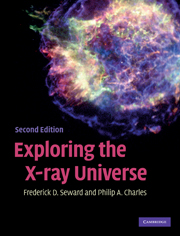Book contents
- Frontmatter
- Contents
- List of acronyms
- Foreword
- Chapter 1 Birth and childhood of X-ray astronomy
- Chapter 2 X-ray emission and interaction with matter
- Chapter 3 Tools and techniques
- Chapter 4 Solar system X-rays
- Chapter 5 X-ray absorption and scattering in the Interstellar Medium
- Chapter 6 Active stellar coronae
- Chapter 7 Early-type stars
- Chapter 8 Supernova explosions and their remnants
- Chapter 9 Neutron stars, pulsars, pulsar wind nebulae, and more supernova remnants
- Chapter 10 Cataclysmic variable stars
- Chapter 11 X-ray binaries
- Chapter 12 Black-hole X-ray binaries
- Chapter 13 Normal and starburst galaxies
- Chapter 14 Active galactic nuclei
- Chapter 15 Clusters of galaxies
- Chapter 16 The diffuse X-ray background
- Chapter 17 Gamma-ray bursts
- Index
- Plate section
Chapter 4 - Solar system X-rays
Published online by Cambridge University Press: 05 June 2012
- Frontmatter
- Contents
- List of acronyms
- Foreword
- Chapter 1 Birth and childhood of X-ray astronomy
- Chapter 2 X-ray emission and interaction with matter
- Chapter 3 Tools and techniques
- Chapter 4 Solar system X-rays
- Chapter 5 X-ray absorption and scattering in the Interstellar Medium
- Chapter 6 Active stellar coronae
- Chapter 7 Early-type stars
- Chapter 8 Supernova explosions and their remnants
- Chapter 9 Neutron stars, pulsars, pulsar wind nebulae, and more supernova remnants
- Chapter 10 Cataclysmic variable stars
- Chapter 11 X-ray binaries
- Chapter 12 Black-hole X-ray binaries
- Chapter 13 Normal and starburst galaxies
- Chapter 14 Active galactic nuclei
- Chapter 15 Clusters of galaxies
- Chapter 16 The diffuse X-ray background
- Chapter 17 Gamma-ray bursts
- Index
- Plate section
Summary
The production of planetary X-rays
Planets are small and, compared to the cosmic subjects of other chapters, extremely weak sources of X-rays. Nevertheless, X-rays have now been detected from five planets, moons of Earth and Jupiter, several comets, and diffuse material in the solar neighborhood. These results have been scientifically useful and often surprising. The strongest X-ray source in the Solar System is, of course, the Sun. As in the visible band, orbiting solid objects shine with reflected solar energy. The soft X-ray luminosity of the solar corona is ∼4 × 1027 erg s−1, and that of the planets is a factor of ∼1014 weaker. Cometary X-rays are produced by collisions of energetic solar-wind particles with material in the comet. Some planets have magnetospheres which provide a mechanism for generating auroral X-rays. The energy that drives almost all these X-ray production processes originates in the Sun.
The observations are difficult, as targets move appreciably during the observation and are very bright optically; so bright that star sensors for aspect determination sometimes cannot be used. Soft X-ray detectors are also sensitive to visible light, which makes data reduction difficult. This chapter will cover Solar System objects in approximate order of X-ray detection.
Earth
In some of the very first X-ray astronomy observations, solar X-rays scattered from the upper layers of the Earth's atmosphere were detected with rocket-borne proportional counters (Harries & Francey, 1968; Grader et al., 1968).
- Type
- Chapter
- Information
- Exploring the X-ray Universe , pp. 39 - 50Publisher: Cambridge University PressPrint publication year: 2010



